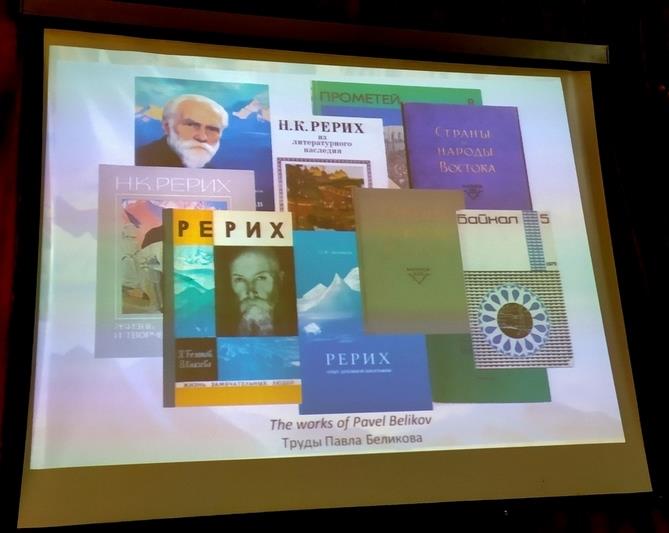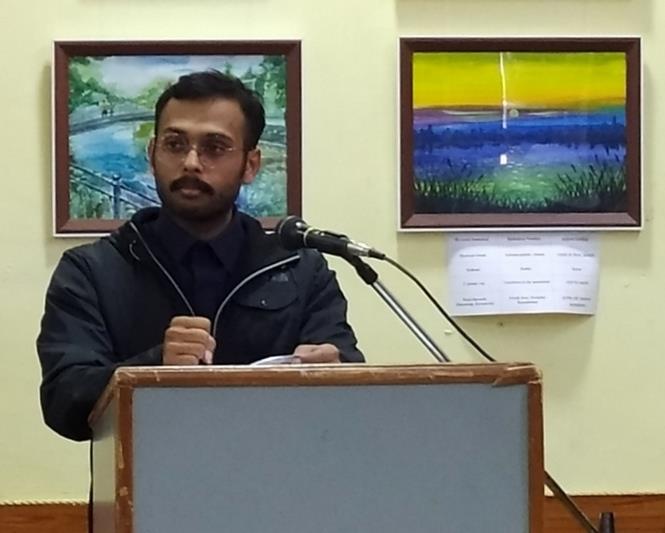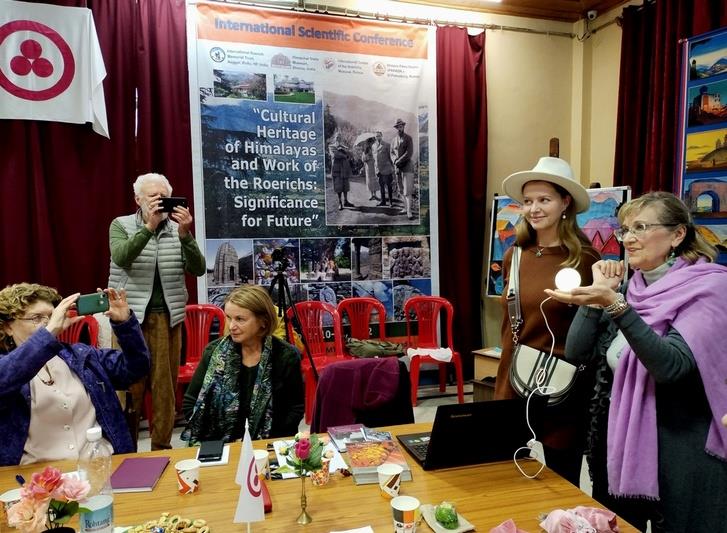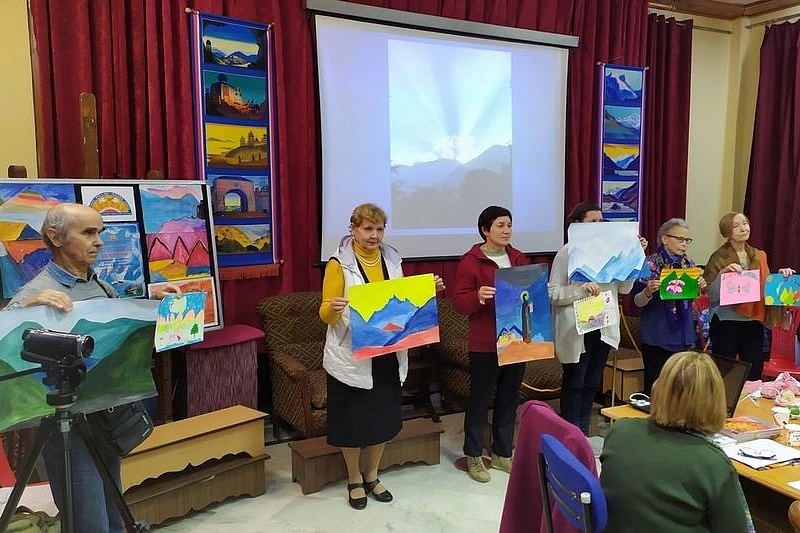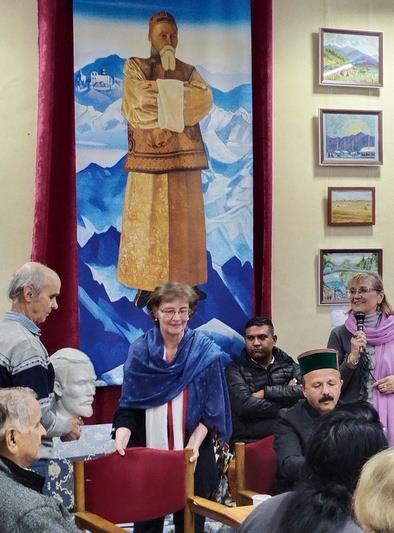International Conference in the IRMT “Cultural Heritage of Himalayas and Work of the Roerichs: Significance for Future”. Day Two

|
The second day of the Conference in the International Roerich Memorial Trust organized by the Himachal State Museum (Shimla, India) in cooperation with the International Roerich Memorial Trust, the International Centre of the Roerichs (Moscow, Russia) and “Faraon” Historic Films Studio (St. Petersburg, Russia) was opened with an inspiring talk by Dr. Om Kumar Sharma, the founder and head of the Sanskrit School in Kullu, India.
Dr. Om Kumar noted that Nicholas Roerich had many talents, many wonderful qualities, all of which were manifestations of the Divine, High Energy, and we are fortunate to have an example of such a person. Everything he did and his cosmic philosophy, which is meant to elevate the man, all these were due to that force which brought him from Russia to India. Dr. Om Kumar recalled the scholar, Buddhist and Buddhologist Tsering Dorje, who said that Nicholas Roerich was not just an ordinary man, he was the man of the higher rank, and what we know of him as an artist is not all – we need to study the higher aspects he embodied. We can talk about a thousand aspects that are present in Nicholas Roerich's work, Dr. Om Kumar noted. But the most important thing is that he was not just a son of the East or a son of Russia – he was a man sent to us by the Universe.
Mr Anatoly Lebedenko, Ph.D. in Pedagogy and Philosophy, Deputy Head of the United Scientific Center for Cosmic Thinking of the International Center of the Roerichs (Moscow, Russia) was not able to come to the Conference and sent his video-presentation “The Roerichs – Founders of the Urusvati Institute” for the Conference. The report is devoted to the history of creation and multifaceted activity of the Urusvati Institute created by the Roerichs in Naggar. The main attention is paid to the issue of cooperation between Russia and India in the activities of Urusvati. The report emphasizes that despite its remoteness from Russia, the Urusvati Institute contained all the peculiarities of Russian centers of science and culture. This largely determined its international specificity and showed a unique example of synthesis between the cultures of the two countries, Russia and India.
Mr Rinad Minvaleev, the assistant Professor of the Department of physical training and sports of St. Petersburg State University (St. Petersburg, Russia) presented the report on “Physical Reconstruction of the Tibetan Yoga Tummo”. The scientist reminded of the painting by Nicholas Roerich called “Tummo” (“On the Heights”), where a lonely yogi sits on the top without clothes and does not feel cold. This ability of the Tibetan yogis who practice Tummo to resist the extreme cold was the subject of study for a group of scholars and researchers led by Mrs Irina Arhipova, the founder and producer of the “Faraon” Historical film Studio, the author of the project “In Search of Lost Knowledge” and organizer of numerous expeditions, including those to the Himalayas. The report presents the results of the conducted researches, as well as the methods developed by scientists on how to withstand the cold without a stressful response.
“The Concept of Psychic Energy in the Philosophy of the Living Ethics” was the topic of the speech of Mr Pavel Zhuravikhin, the Executive Secretary of the International Center of the Roerichs (Moscow), advisor of the Russian Academy of Natural Sciences. In the first half of the 20th century, as a result of many years of collaboration between Nicholas and Helena Roerich and a group of great spiritual Gurus of India, a philosophical system was created called the Living Ethics, or Agni Yoga. According to the energetic worldview of the Living Ethics, the unity of the Universe is ensured by the Universal cosmic energy, which is called psychic energy as applied to a human being. Knowledge of the properties and qualities of this energy, which we find in the Living Ethics, expands our knowledge and opens up new opportunities for science to study the subtle material physiology of the human organism. The speaker emphasized that the scientific study of psychic energy will contribute to the spiritualization of all human life and the formation of a new consciousness of mankind.
The report “Science and Living Ethics in Contact with Life” presented by Mrs Marina Tarasova, doctor on diagnostics and correction of energy-information fields (Kurgan, Russia), was prepared by her in co-authorship with her colleague Dr. Tatyana Bulatova, psychologist, a Master of Science in Biology, Associate Professor of psychology department of Kurgan State University. The speaker noted that in the Living Ethics it is spoken about mastering new energies in an experimental way, with the help of physical devices. Such a device was the apparatus invented by the Kirlian couple in 1949. It made it possible to photograph the amazing glow emanating from plants, human fingertips and other objects. The glow is a flow of electrons traveling in a high-frequency field. So in the hands of researchers appeared a tool to observe, study and take pictures of invisible to the eye radiation. The results obtained in the course of the research carried out by the authors of the report for the past 20 years allow to study the psychic energy and its influence on man and nature, as well as to analyze the human conditions on the Kirlian apparatus and give certain recommendations.
Dr. Marina Tarasova brought the device with her to the IRMT and invited everyone to check their condition and see the world of subtle energies with their own eyes.
Mrs Tatyana Kupava (Russia, Crimea), the Roerichs researcher and a member of the Council of Roerichs' Organizations devoted her presentation to Pavel Belikov (1911-1982). The title of her presentation was “Pavel Belikov – the Roerichs’ biographer. Work for the Future”. He was born in Estonia and lived there for all his life. He was introduced to the books of the Living Ethics in the 1930s, and they became the basis of his worldview. With a deep knowledge of philosophy, literature, poetry, he made speeches; he also prepared several reports on Roerich. The great artist, living at that time in India, learned about the talented young man and wrote him a letter. This greatly inspired the young researcher, and he began to collect Nicholas Roerich's archive, and in the future the archive of the whole family. Thus he embarked on the path of service to the Culture. The archive collected by Pavel Belikov numbers over 40000 units: books, photos, publications about Nicholas Roerich, his letters and essays. Materials were collected with the help of the Roerichs themselves and their closest associates. The books and articles written by Belikov became the beginning of serious scientific Roerich studies.
Mr Gautam Kashyap, a researcher and translator from Bihar, India, and graduate of St. Petersburg State University, gave a talk entitled “A Comparative Analysis of the work of Rahul Sankrityayan and Nicholas Roerich”. He introduced the audience to a brief biography of Rahul Sankrityayan, an Indian writer, translator, traveler and scholar, who had come a long way from a Hindu and Buddhist monk to a communist-thinker. By his profound knowledge he earned the title of Mahapandit, that is, a great scholar. We also remember that Nicholas Roerich was called Maharishi – for his great achievements for humanity.
A young researcher from Delhi, Mr Arjun Shivaji Jain, the director of the Red House Cultural Center, presented “Messengers of Aesthetics and Ethical Values: Tolstoy, Tagore and Roerich.” The great personalities of the 20th century, with their tremendous thinking, writing, and artistic talents, they became true teachers of life and sages for the people of Russia and India, bringing good to the mankind. The speaker shared with the participants of the Conference his vivid impressions from visiting Yasnaya Polyana, Russia and Shanti Niketan, India and expressed his gratitude to the fate that brought him to Nicholas Roerich Estate.
Mrs Olga Karaseva, the moderator and interpreter at the Conference, presented her paper “Culture as a Universal Language of Unity (based on the works of the Roerichs).” The Roerichs lived in the era of numerous inter-ethnic and inter-cultural conflicts and wars, similar to the one we have also lived in, an era of substitution of values and meanings of concepts. It is in this era when thoughts about cultural unity and the construction of a new society based on the concept of culture are especially relevant. Cultural unity opposes narrow nationalism. The Roerichs believed that cultural unity is built on the acceptance of historical experience, the interrelation of generations, succession and depth; orientation towards establishing contacts, mutual understanding, common historical memory; mutual respect, co-creativity and cooperation.
The logical conclusion of the Conference was the report of Mrs Natalia Bazhenova, Deputy Head of the Nicholas Roerich Cultural Centre, Head of the Applied Art Department of the State Museum of Kazakhstan named after A. Kasteev, Member of the Union of Artists of the Republic of Kazakhstan “Svetoslav Roerich and Lyudmila Shaposhnikova about the Kullu Valley”. The speaker noted that Kullu Valley takes the central place among the surrounding mountain valleys, uniting them into one historical and geographical whole. The Kullu Valley can be rightly considered a rich historical, ethnographic, cultural and natural reserve. It is not by chance that the Roerichs founded the Urusvati Institute here. The works of Svetoslav Roerich and Lyudmila Shaposhnikova contain valuable research and materials, which give a big opportunity to study various aspects of history and culture of the Himalayan Kullu Valley.
This concluded the two-day Conference on the cultural heritage of the Himalayas and the work of the Roerichs. In his closing remarks, Dr. Hari Chauhan thanked all the organizers and participants of the Conference and expressed his hope that the Conference was interesting and that everyone learned something new for themselves. Dr. Chauhan noted that Indian and Russian scientists showed mutual interest and found many points of contact. In her turn, Mrs Larisa Surgina, the Russian Curator of the International Roerich Memorial Trust on behalf of the Russian-Indian IRMT team thanked Dr. Hari Chauhan and the staff of the Himachal Pradesh Museum, the authorities of the International Center of the Roerichs and its group of volunteers, as well as the “Faraon” film studio for cooperation in organizing the Conference.
The Conference ended warmly and cordially. The guests were given gifts, memorable prizes and souvenirs. The Conference was another important contribution to strengthening friendship and mutual understanding between our nations.







